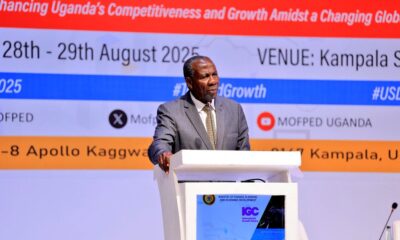Columnists
We’ve restored growth; let’s transform
To achieve development and other national goals, Uganda must stop ad hocism

Some of the Board members of Uganda Development Corporation (UDC) R-L: Ramathan Ggoobi, Josephine Okot, Ham Mugenyi (Board chairman), Godfrey Byamukama and Emmanuel Mutahunga (Ag ED)
After six years of muted performance, Uganda’s economy is once again growing. Last year it grew at 6.1% (driven mainly by resurgent agriculture and services sectors). This year, growth is projected to rise to 6.3%. The International Monetary Fund (IMF) projects Uganda’s growth could reach 7% in the next five years.
This is great news to Ugandans. The economy has in the past six years struggled to grow, registering average growth rate of 4.4% between 2012 and 2017. Uganda’s target growth rate (one that would enable the country to achieve national goals) is 6%.
Now that we have restored growth to the target level, soon words such as “robust growth”, “sustained growth” or “unstoppable progress” will once again be chorused by authorities. Why not? Who doesn’t celebrate growth and its accessories?
Not me. As a passionate follower and researcher of Uganda’s economy, I know that even when the economy was growing, the growth profile remained jobless, unequal, and barely sustained.
The growth was driven either by low productivity sectors or high productivity sectors that do not create jobs. Services such as trade and commerce, real estate and construction, finance, telecommunication (including mobile money transactions), transport, tourism, and government administration are some of the main drivers of Uganda’s growth.
Growth-promoting structural change
The essential problem with these services is that they tend to require relatively high skills. Long years of education and institution building are required before farm workers can be transformed into programmers or call center operators.
So raising productivity in services to create productive jobs typically requires steady and broad-based accumulation of capabilities in human capital, institutions, and governance. Achieving significant productivity gains in services depends on complementarities across different policy domains.
In addition, services are less tradable (exportable) and more context-specific, with some exceptions such as cell phones and tourism. These are some of the reasons services have traditionally not acted as an escalator sector.
Services are good at employing people that have already undergone transformation. Not the caliber of labour in Uganda today. It is manufacturing and commercial agriculture that would create growth-promoting structural change in Uganda.
Unfortunately, agriculture where three quarters of Ugandans are working has had the lowest labour productivity. Yet countries such as China and Vietnam benefited greatly from an early spurt in agricultural productivity, driven by massive public investment.
Opportunity entrepreneurs
Like I have written in these pages before, Ugandans need factories where they can supply their labour and energy that they are wasting away in sports betting shops and on streets running around with self-serving politicians. Manufacturing is the sector that will create lots of low skilled but productive jobs to Ugandans.
As a demagogue promoter of industrialisation, I often tell audiences that countries were built by factory workers employed by “opportunity entrepreneurs”; not by necessity entrepreneurs.
Most people now agree with this. What is not yet clear to them is how these industries (manufacturing factories, agro-industries, and other value addition plants) can be built and sustained.
Research shows that everywhere in the world industrialisation required proactive government involvement. All industrialised nations used industrial policy – government directly investing in industry and/or subsiding privately-owned investments – to establish robust manufacturing firms.
The problem in Uganda, like in other countries, is that government tends to be inefficient, wasteful, bureaucratic, and most importantly disorganised to do business. This exactly is the reason many people have reservations when it comes to involving government in building and/or running industries and other businesses.
UDC to lead the way
Yet nearly all industrialised countries have quite successful state-owned and run industries and businesses. How do they do it? How do they manage the governance aspects of state-owned corporations to ensure results and minimise abuse? How do they build investment and enterprise management competences of their corporations?
Furthermore, how do successful state-owned corporations ensure prudent budgeting to achieve high performance? Which internal controls to they use to ensure efficiency and effectiveness? How do they go beyond routines such as setting up of policies, plans, processes and procedures and turn them into results?
When government appointed us to the Board of the revived Uganda Development Corporation (UDC) recently, these are some of the questions we were grappling with.
We set ourselves a task of building a UDC that can incubate industries with a view of passing the mature industries on to private sector for better management and sustainability.
Apart from jobs, the UDC we are building is going to lead the creation of value for export (to earn foreign exchange to bailout the shilling), invest in areas with greatest multiplier effect, and maximise the utilisation of local raw materials.
Avoid politically-driven “investments”
We are going to set up a fund to support local firms to be competitive in the domestic, regional and international markets with a focus on high-value output. We want to work with private sector innovators to develop concepts for investment which can be supported with venture capital. We are also engaging potential investment partners to co-finance some of these investments.
Some people have been asking: where is UDC? What are they doing? Are they asleep? Some, may be rightly so, are saying visibility is now a factor of production. Some are not even aware that the debate has just shifted from “government has no business in doing business” to “where is UDC; are they asleep?”
Well, UDC has silently been reinstating itself, putting in place proper governance and management structures as well as new strategic and investment plans. Soon we shall relaunch ourselves with something valuable to offer.
We are building a UDC that is not for a show but capable of spearheading the industrialisation of Uganda through venture capital, equity, debt, guarantees, and technical advisory services to young Ugandan entrepreneurs (supporting startups and distressed companies).
We are building a UDC that is capable of screening out rent-seekers and thus reduce adverse-selection problem (attracting fake investors) that had become a new normal in Uganda. We are crafting a UDC that will erase memories of politically-driven “investments” that ended up costing the taxpayers billions.
Factories, jobs, export receipts
We are putting together a UDC that will relieve Government leaders the burden of running around shopping for investors. All that Government will do is to give UDC seed money, autonomy in decision making and operations, and targets. Then, leaders will remain with one task: to sack UDC managers if they fail to deliver results. Accountability at UDC will be results – factories, jobs, export receipts, household incomes, regional balancing of development. Not paper accountability.
To achieve these, UDC will need full support from all quarters, but most importantly from government leaders. The past gives enough lessons to leaders at all levels to understand that no amount of doing the same will bring different results. For Uganda to benefit from investors (foreign and local) and to deploy resources productively, ad-hocism must stop.
Politicians should stop appraising investors without involving the technical people and relevant institutions set up to help them do such work more professionally. Best practices show that only those countries that gave their state corporations autonomy and support in the form of capitalisation and political support, succeeded at industrialisation.
In Kenya, for example, the Industrial and Commercial Development Corporation (ICDC), is successfully managing a host of very successful businesses in areas such as agro-chemicals and industrial spirits; steel; Development Bank of Kenya; Almasi – Coca Cola; Isuzu East Africa; EverReady Batteries; breweries, wines and spirits; logistics; healthcare facilities; hospitality (hotels and shopping malls); private equities such as Centum PLC, and many more.
ICDC (incorporated in 1954) benchmarked UDC (founded in 1952) before the storm of Washington Consensus killed the latter. As the UDC Board, our aspiration and national contribution we would like to make is to revive and surpass the glory the old UDC created for our country. All we are asking for are two things: support in the form of capitalisation and political support. Is that asking for too much?
Comments





















